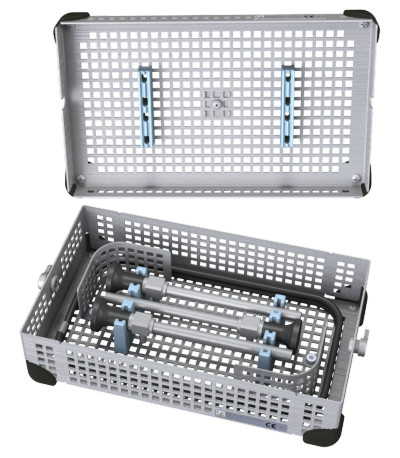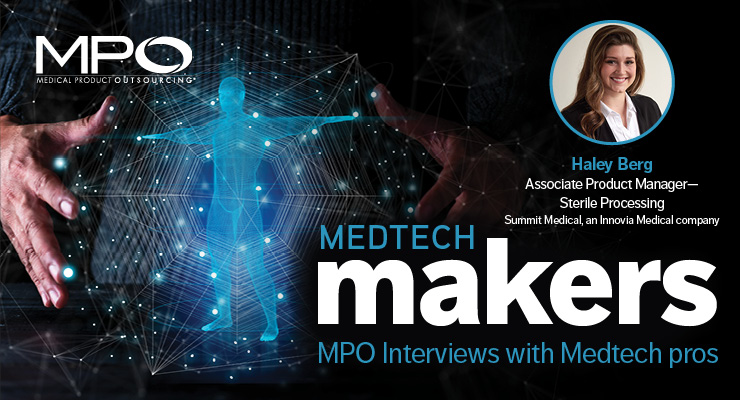A medical instrument is often a delicate and expensive piece of equipment. In addition, it needs to go through rigorous cleaning and sterilization protocols to ensure patient safety. As such, it must be well protected when transported or even within a surgical suite. For this reason, a tray is a critical component to accompany it.
The tray, however, can bring its own challenges for a medical device manufacturer. If they develop one internally, it must meet the needs for its usage environment, in addition to facing regulatory and quality challenges. A validated tray provider, on the other hand, can eliminate time and costs involved with a custom solution, while still offering a degree of design freedom for the customer.
Seeking to clarify misconceptions and any confusion around the use of an already validated tray is Haley Berg, associate product manager of sterile processing at Summit Medical, an Innovia Medical company. She offers insights on why device manufacturers may be better served in selecting a validated tray from a preferred supply partner.
Sean Fenske: What types of expertise are companies seeking in an instrument tray partner?
Haley Berg: Selecting an experienced tray manufacturer is key to the success of designing a tray to fit your instrument needs. A few areas that are crucial to your success include their knowledge around global regulatory environments within medical device, as well as being a manufacturer who understands the importance of speed to market. Your instrument launch and meeting your go-to-market strategy should not be compromised. Additionally, it is crucial to consider the lifespan of your product itself and the quality of materials being sourced in designing a tray that will extend the life of your product.
Regulatory expertise: As a trusted medical device manufacturer for over 30 years, Summit Medical has invested countless hours and financial resources into the development of a strong QARA system. This includes nine 510(k)s that represent different sterilization modalities, ISO 13485, CE Self Certification, and international distribution presence.
Speed to market: When searching for a validated tray manufacturer, it is important to partner with a company with speed and precision. Summit Medical has decades of experience bringing sterilization trays into global markets.
Customization and instrument protection: Choosing a validated tray partner with customization capabilities and instrument protection as a priority will help support the longevity of your instrument(s). At Summit Medical, our protection tray experts are backed with industry experience in sterile processing and this knowledge is important in the designing and final functionality of your trays to ensure the best cohesion with the end user.
Fenske: What are the common challenges encountered when a device manufacturer tries to get a tray validated that hasn’t already gone through the process?
Berg: The key challenges are based on development time, financial resources, and expertise. If a device manufacturer were to bring a validated tray to market within the U.S. on their own, it requires an independent 510k, which reinforces the challenges around timing, financial resources, and expertise. These requirements may result in the process taking one to two years to complete regulatory submissions, review 510k drafts, and receive final FDA clearance. When you partner with a company such as Summit Medical, we alleviate the burden of you doing this on your own, allowing you to focus on the design and commercialization of your product. We understand the regulatory requirements required that can help you alleviate financial constraints and increase speed to market.
Crucial capabilities to identify with a protection tray manufacturer:
- 510k clearances
- CE Certified
- Tech files
- Country registration history
-
Reprocessing knowledge
- Tray size versus instrument size
- Standard DIN sizes
Fenske: How much time and/or cost savings can be realized by choosing to use a validated tray?

Validated trays can be modular, enabling multiple variations or design configurations to be created depending upon an OEM’s preference and its end user.
Berg: Selecting a validated tray manufacturer can be difficult, but it doesn’t need to be. Summit Medical focuses on customization and instrument protection; in addition, we can offer comprehensive regulatory leverage and expertise. This includes ISO certifications, more than 30 languages translated into an IFU (instructions for use), nine FDA 510(k) clearances, tech files, material specifications, and more. All these things, if completed alone, can cost upwards of $100,000 to $200,000. When partnering with Summit Medical, these costs have been internally paid for and absorbed, allowing device manufacturers full access to the information as the distributor of the product without the price tag.
Fenske: Do companies believe using a validated tray will limit flexibility in tray design/set-up? What do you tell them in response?
Berg: A general misconception in the market around validated manufacturers is that you will get stuck with a preconfigured tray design. When in reality, it is quite the opposite. A validated tray manufacturer will hold all the responsibility around quality and regulatory labeling, but outside of this, there are a lot of options when it comes to customization. Summit Medical offers some of the most cutting-edge designs and options in the market. We offer multiple labeling, branding, and anodization options. Our validated trays are modular, allowing for multiple variations or design configurations depending on your preference and end user.
Fenske: Does using a validated tray require any specifications to be kept in mind with regard to the design of the device for which it will be used?
Berg: Weight and dimensions of the instrumentation should be taken into consideration. Partnering with a manufacturer who understands the standard industry sterilization chamber sizes can be beneficial before getting to a design freeze on your instruments. It is important to also know what sterilization cycles your instrument will be validated for so the sizes of these chambers can be considered. These things need to align with reprocessing specification within the IFU.
Fenske: At what point in the product development process should a medical device manufacturer inquire about a validated tray? Since it is already validated, can this aspect take place at the end or should it happen earlier?
Berg: Device manufacturers should be reaching out as soon as possible so they do not encounter delays to market. There are two critical factors for. One is when a design freeze on the instrument is near completion; this is a good time to start working with a tray partner. Second is developing reprocessing instructions for the end users. Both are critical to the pathway to market and need to align with the commercial release of the product.
Fenske: Do you have any additional comments you’d like to share based on any of the topics we discussed or something you’d like to tell medical device manufacturers?
Berg: Though it may not be at the top of your list as a device manufacturer, it is always crucial to factor in the need for a sterilization tray and/or how your device will be handled by sterile processing teams and surgeons in the hospital. If a tray is not available for your customers, it is likely you will see improper usage and damage to the device. In order to offer a complete system (i.e., sterilization tray, instrument, IFU), you will have to consider reprocessing requirements, end-customer usability, desired longevity, and the right manufacturer that fits your needs. Summit Medical’s team of sterile processing experts welcome the opportunity to collaborate with you. Contact us for a free consultation and see how we can help you bring your product to market.
Click here to discover more about Summit Medical >>>>>












